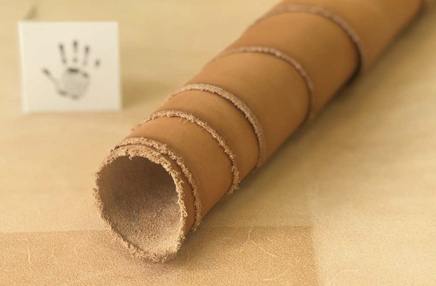The leather in hoodmaking is one of the most important and significant aspects of the job. The quality and beauty of the product directly depends on how high-quality the leather will be. It is very difficult, if not impossible, to achieve great results using medium to low quality leather in the manufacture of hoods. I use mostly vegetable tanned leather, that’s why I’ll write about it here.
For myself, I identified several of the following problems, or tasks, regarding leather, which, perhaps, every hoodmaker has to solve. These are:
- the skin must be perfectly flat on each side, the flash side must be flat and dense in order to exclude torn punctures with an awl and ensure reliable stitching in the future;
- leather should be made using the highest possible quality set of vegetable tanning agents (this is possible only for high or premium leather) and the quality of tanning agents affects how the leather will be molded on the block. Quality leather in a wet state, similar to plasticine, is light and pleasant to work on the block while shaping the hood;
- leather dry, should not stretch. If the leather initially stretches, it may be difficult to sew, and when working on the block, such leather in most cases will not allow the hood to be even and symmetrical;
- leather should be tight enough, but not too hard. High-quality vegetable-tanned leather, initially being even of medium density and quite soft, after soaking and drying on a block, keeps its shape perfectly.
The Leather must be the correct thickness
I make hoods in 16 sizes, from the smallest male peregrine falcon to the largest female gyrfalcon. The thickness of the leather used varies from 1.25 (3) mm to 1.55-1.6 mm. It is very important that each size is made from leather of the correct thickness. In general, small hoods on my list of sizes are made of leather with a thickness of 1.25-1.33 mm, medium hoods – 1.33-1.38 (4) mm, medium-large – 1.4-1.45 mm, large – 1.45-1.55 (6) mm.
Finding the right leather thickness is, in my opinion, one of the big challenges for hoodmakers, because leathers of the standard 1.2-1.4mm thickness often do not contain a large number of sections of thickness needed to create a certain size.
After a lot of trial and error, I came up with leather splitting. After the leather comes from the factory, I send it to splitting at the desired thickness. This helps not to get into a situation of large excess of unnecessary skin, as well as always have skin of the required thickness on hand.
For the past six months I have been using leather from the same Italian tannery that meets all my requirements. It is premium quality leather in several colors including Camel and medium brown. Sometimes it is not easy to create hoods in different shades than the ones listed above, but for me the quality of the leather and the confidence in the resulting product come first.
Regards,
Artem Smolyuk

